
|
In
February 1974 I was the Government Representative and Secretary on a
delegation to the Soviet Union with some people from CNR and CPR to
examine Soviet railways under winter conditions. I took a
portable tape recorder with me and these are my transcribed notes. The
other members of the party were:
I set off by rail to Montreal for a meeting with the rest of the group. It was very cold and the sun was shining brightly. There hadn't been much snow recently and that which had fallen had turned to ice and was reflecting the sunlight. Typical eastern Ontario scenery with log cabins and wooden fences. The club car didn't ride too well but I could eat my breakfast without too much of a problem. We arrived in Montreal about 15 minutes late. I caught the BOAC flight 600 to London at 2300 (30 minutes late - no announcements in French). Instead of orange juice I was given orange squash - tastes pretty awful. My companion was a funny little man who didn't seem to know where he was going. He kept asking, "Is this one going to London?" (or Mitcham or Newcastle). The cabin crew kept a close check on him and made him take his pills. Saturday 2 February Arrived London 15-30 minutes late and was met by Dad and Uncle Jack. There were a lot of people wearing turbans both in the British Subjects line and working at cash desks etc. We drove straight back to Orpington through New Cross. Orpington High Street has a few empty stores, very few lights because of the energy crisis. There is a great shortage of toilet paper. Dad still takes down the Saturday football scores for the pools. In the evening we went for a drink to the Beech Tree and the Anglesey Arms - had a good selection of all types of beer. Sunday 3 February I visited the neighbours then had a drink at the Bo Peep in Chelsfield. In the evening Dorothy and Ron drove me to the Holiday Inn by London Airport where I spent the night because my flight left early the next morning. The TV closed down at 2230 and people were asked to turn off electrical appliances. Monday 4 February I caught the Air Frane flight to Paris (no security check) and met up with the rest of the group for the Aeroflot flight to Moscow. A lot of plastic is used in the interior of the plane and a very strange perfume is used. The food was prepared by Wagon Lits. (Cold mushrooms, cold cuts, red wine) We were met at the airport by the head of the Soviet delegation, Mr. Pashinin, and their interpreter, Boris Lukov, as well as Gerry Dyell from the High Commission. I had a little difficulty in that I had come from London although my ticket was marked Montreal. There were some problems with baggage but we eventually got downtown to the Hotel Intourist (2½ hours after we landed). It was dark as we left the airport. There were many people walking around. The rush hours are staggered. There were some buses with vestibule connections as well as trolley buses (also vestibuled). My room was quite comfortable with a good carpet, complete with a large ink stain. The blanket is tucked around the sheet which made it interesting to sleep in. Bath, shower, heated towel rail, radio etc. On each floor there is a woman who keeps the keys and generally keeps an eye on things. Our first meal was excellent, - Sturgeon in aspic with pink horseradish sauce; Sturgeon and Salmon caviar, black bread. - Filleted chicken leg, fries and peas. - Sweet coffee. Accompanied with much old vodka. We were given vouchers for our stay in the hotel for breakfasts. These were obviously used over and over again as they were dated 1970 and 1971 while one had jam on it. Tuesday 5 February It is mild, around freezing and there is a light snow falling. Breakfast was black tea, kafir, boiled eggs (from a big bucket) Stirling Smith and I took a look around Red Square in spite of the snow. There were many tourists, mostly from other parts of the Soviet Union. We watched an old woman sweeping off a slight covering of snow. There was a good meeting at the Ministry of Railways - an old building. The room had a picture of Lenin and this was a common feature of all rooms in which we used. In the afternoon we met Mr. Ford the Canadian ambassador. He is a very learned academic man who spent much time telling us about Russia. He has bad arthritus in his legs which causes problems getting into and out of a chair. He pointed out that the Soviet Union is probably less egalitarian than our own society. The average wage is around 100 rubles a month yet many of the elite make 1000 rubles a month. However, this is still better than under the Czars. We visited a tourist shop that will only accept foreign currency, then walked back through Red Square. It was noticeable how many were out walking. We were asked for gum several times. People are very disciplined as they walk on the right hand side of the sidewalk. In the evening we were taken to the Moscow Circus located in its own building constructed using a lot of glass. The ring is moveable and they can change the surface. The audience was well dressed, often in colourful clothing. The cloakrooms are very large. We had good seats six rows from the front. The acts came from all over the Soviet Union as well as Cuba, Mongolia, Bulgaria, Czechoslovakia and East Germany. There were the usual acts with more emphasis upon human ability than animal acts. Popov, the world famous clown, was very popular. There was a little boy behind me, about Paul's age, his eyes nearly popped out of his head with excitement. He cried when it was time to go home. During the interval we had a beer. We went back to the hotel using the Moscow Metro which is very impressive, stopping off at several stations to view the architecture. The first station was one over the Moscow River, it has very wide platforms and we could see the signal which indicates the train frequency. The second station was one of the original ones, again with wide platforms the length of a football field. There is much use made of marble and there are many decorations in alabaster. The marble, although expensive to purchase, is very serviceable and easy to keep clean. There was a marked absence of litter. The chandeliers were very ornate. Many people have medals which are given for meritorious service. The Intourist girl at the hotel had just been awarded a one and proudly showed it to us. It is very common to see an abacus at cash desks and this is used to calculate change even though there may be a mechanical or electronic cash register. The first one I noticed was in a small kiosk selling bread just outside the Red Square and there were several in the hotel. Wednesday 6 February Today we visited the Central Scientific Research Institute at Cherbinka, some 20 miles away. Again, the temperature was very mild, around 30°F. On the way out we passed a streetcar right of way and saw streetcars with several types of pantograph, railway style, diamond and bow collector. They run in multiple and at quite high speeds, I clocked one at 60 km/hr. 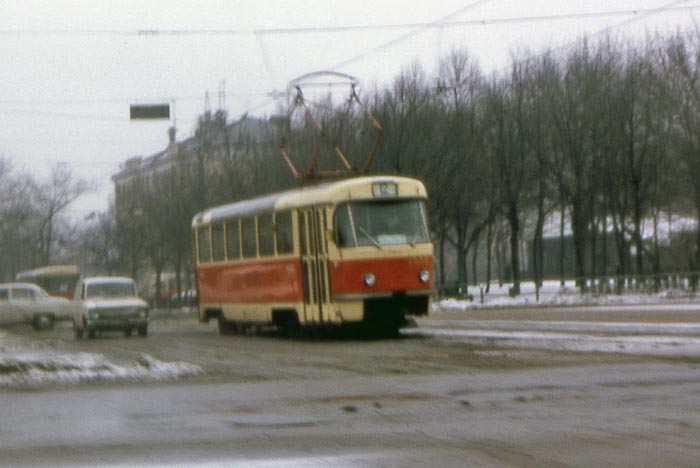 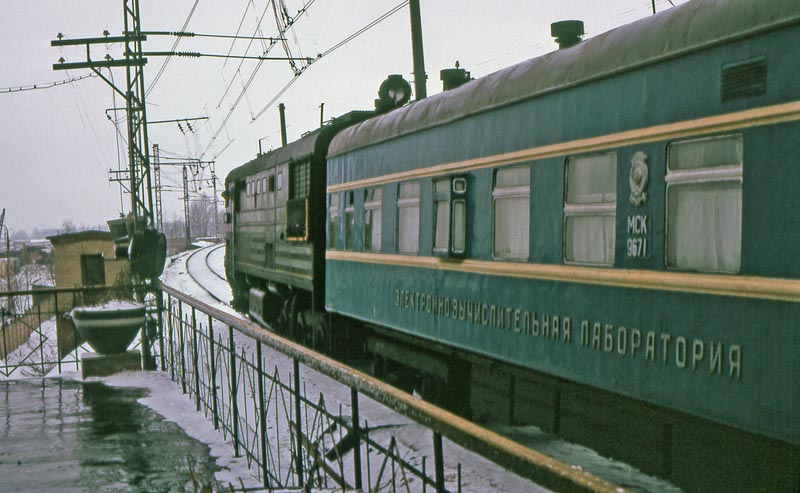 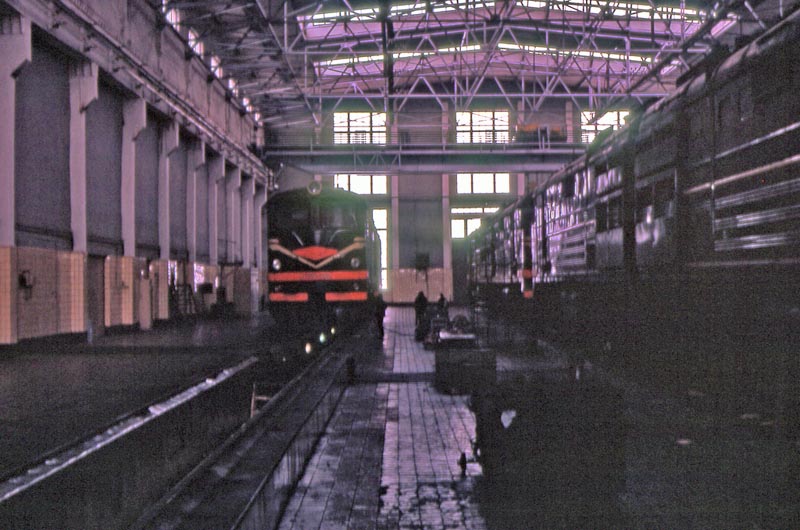 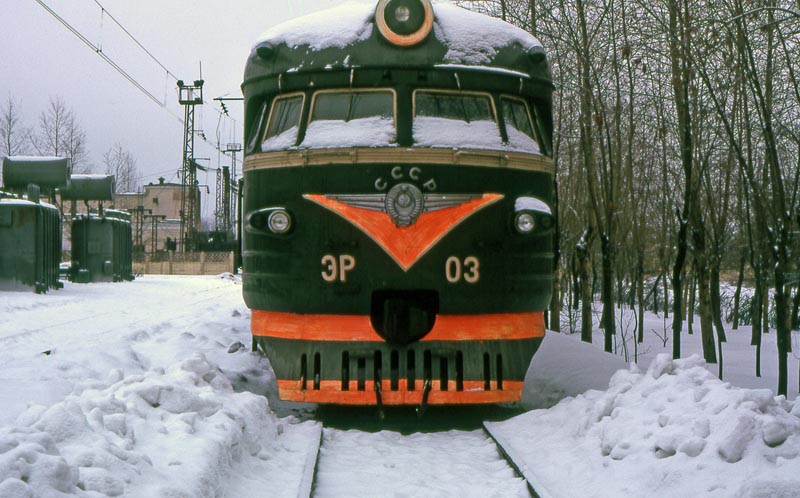 We visited the diesel test shop, the electric shop (squirrel cage motor), traction motor lab., car shop, metals shop and brake laboratory, then rode around the loop. Every night they run a train of sand to achieve 1,000 km per night - very heavy density - to assess wear on track. All rails in the track are tested before and after use for content, flaws etc. Everybody exhibited a lot of pride in the job and everything was spotless. Back in Moscow we visited the Moscow Scientific Research Institute including the automatic brake laboratory. Lunch was hosted by Mr. Koretshaikov: - Hors d'oeuvres - sturgeon caviar - Steak and fries - Ice cream and coffee It was washed down with aged vodka and a drink made from bread. In the evening Mr. Pashinin took us to the theatre in the Kremlin after giving us a brief walking tour of the area. There are several churches, all now museums. The Kremlin theatre is used as a convention centre which will seat 6,000. We saw the Bolshoi Company dance Don Quixote by Minkus. During the first interval we went upstairs to a banquet room which covered the entire theatre. After the performance there was quite a lesson in crowd control at the cloakroom. While the first group were gathering their coats the rest were held back by a chain barrier. When the barrier was dropped the resulting rush was something like the storming of the Bastille. We then moved to the Leningrad station (Moscow) and boarded our private car on the rear of the Leningrad overnight train which left on time at 2340. Thursday 7 February We arrived in Leningrad on time at 0705 and had to get off the car very quickly. The rear two cars had been taken off the train within five minutes. We were taken to the Intourist Hotel which faces out over the river. Our first visit was the Leningrad Hump Yard which was nothing exceptional although we saw a cut of 15 cars being humped. The cars, in general, were not in good condition although the mechanical parts were well maintained. I saw a steam locomotive. We were told it was used to clean cars but I doubt this. 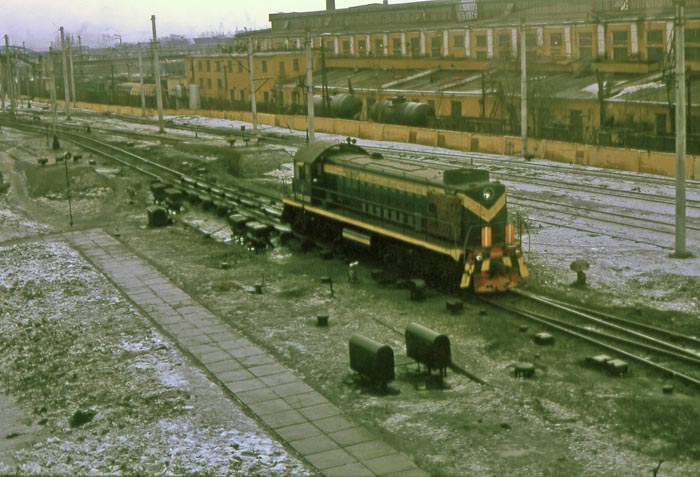  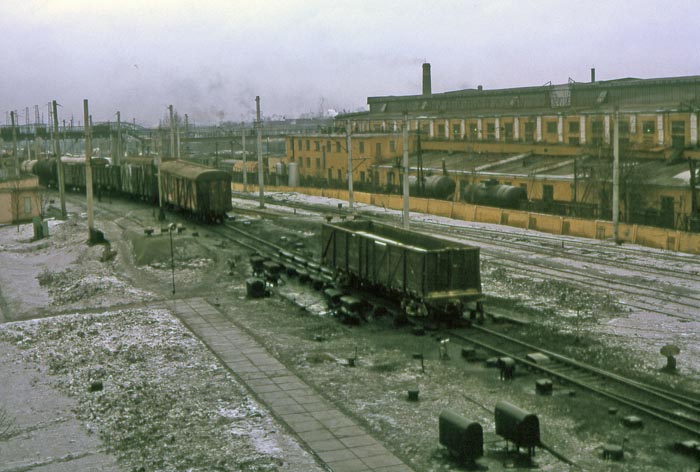 From the Hump Yard we went to the October Car Shop where they repair electric multiple units and subway cars. I had a look at an electric mu 3P110, all green with luminous flashes, red star emblem and a large headlight on the front. In the cab the controls are quite simple - throttle, air brake, hand brake. In the passenger compartment the wooden slatted varnished seats were three aside with luggage racks and coat hooks. The cars were secured by wooden chocks. 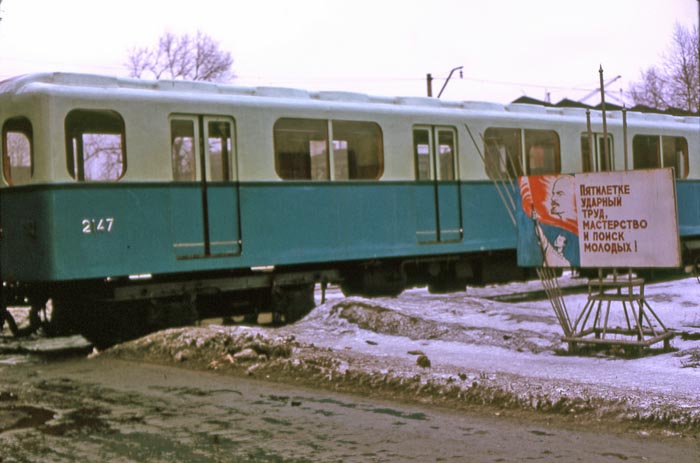 From the plant we went to the Finland station to look at switch heaters. On the way we passed many streetcars with cream upper panels and maroon and black lower panels. Many operated in multiple (with bow collectors) while some had large headlights similar to locomotives'. We stopped in at a foreign currency store on the way back. There were many people but not many were buying. The system is very unwieldy. You make your choice and the assistant gives you a chit. You then pay your money and take the receipt back to the assistant who then wraps the purchase. This evening we went to the Kirov Theatre to see Raymonda by Glazounov. In the first interval we were treated to a sumptuous meal. The room decor was gold and blue with a beautiful ornate chandelier and a ceiling decorated with cherubs. Everyone sat on wooden chairs with blue upholstery. The orchestra was 70 strong and the troupe received a standing ovation for a full five minutes. Friday 8 February From my hotel window I could see the warship Aurora which is now a museum. A car took us to the Leningrad station where we had a special train to look at a high speed switch at Chudovo. On the way through the station we could see the beautiful painted ceiling over the concourse and we waited in the VIP lounge. On the way to Chudovo I noticed several hay ricks with a pole through the middle and a roof to keep the rain off. The roof slides down the pole as the hay is taken from the bottom.  Chudovo 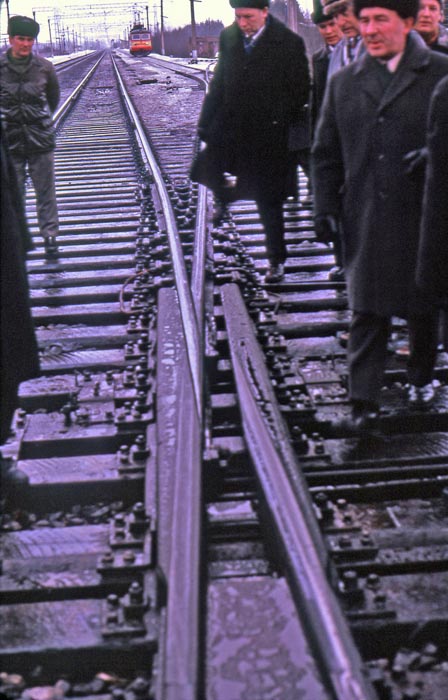 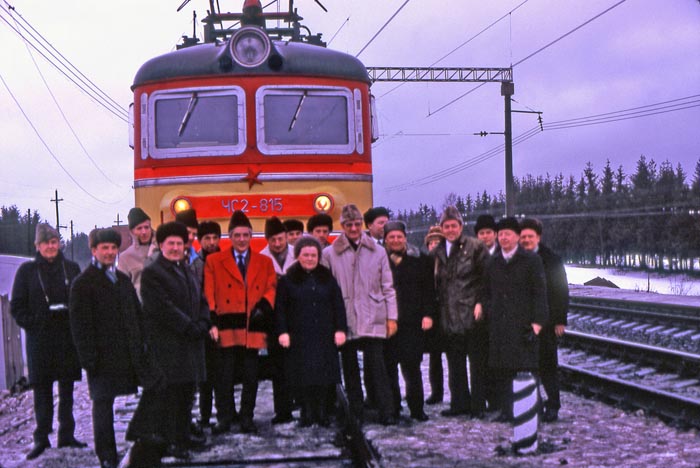 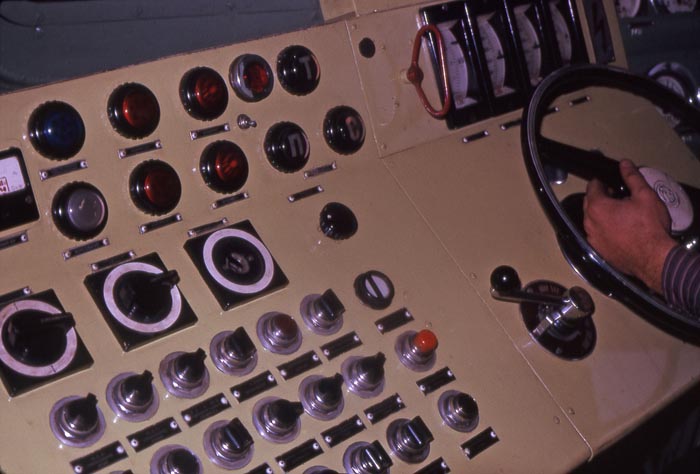  Yellow over yellow 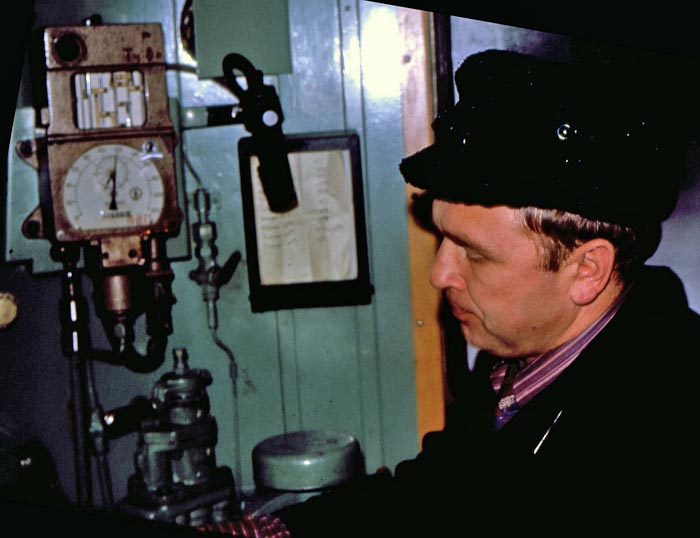 The speedpmeter/tachometer is at the top left Green Yellow Yellow over Red Red We passed many trains on the opposite track on our return - a good indication of train density.
 At Leningrad From the Leningrad station we were taken to the Hermitage Museum and given a guided tour. It is an incredible place with a wonderful selection of paintings although they can only exhibit one fifth of the collection. The settings for the paintings are beautiful. Each gallery is ornately decorated and there is much gilt and inlay work. No western modern art has been acquired since the revolution so that, Picasso, for example, finished before his most well known period. After the Hermitage we were taken for a sight seeing tour in the dark. Leningrad is situated on about 100 islands and 10% of the city is water. The street cars run on separate reservations in some areas and I saw some running up to four cars in multiple. 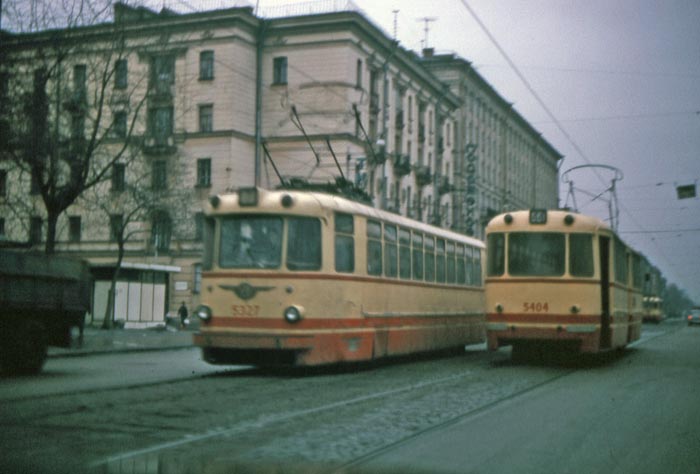 At the station we found our private car to which was attached an additional sleeping car to give us a little extra room. My compartment shared a washroom/shower. There was a bed from the seat, an upper berth, luggage storage over the corridor, a table, seat, lamp, mineral water and a fan. It was very comfortable and ornate with brass door knobs etc. Dinner was in the private car: hors d'oeuvres, fish, liver and mashed potatoes, fruit and biscuits. Saturday 9 February We traveled overnight to Petrozavodsk where our two cars were taken off the train and we had breakfast. 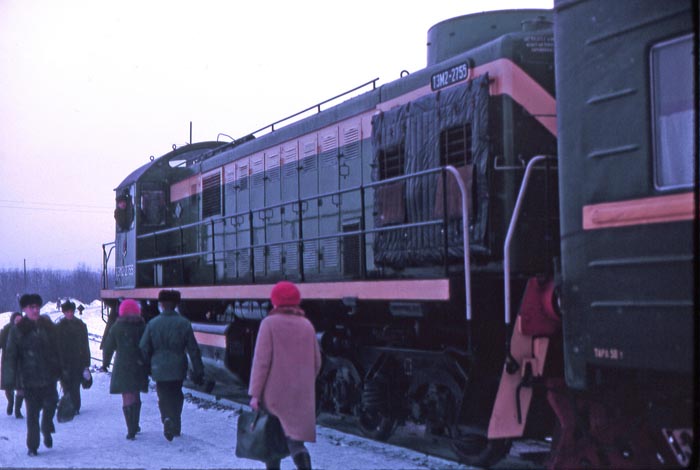 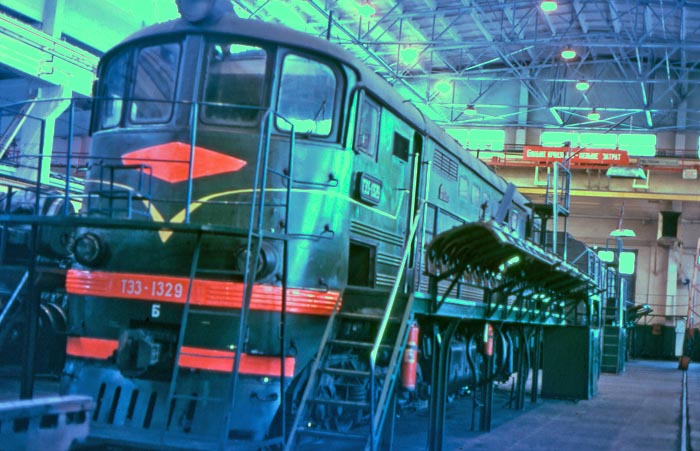 We were then taken by car on a ride outside Petrodavodsk to a health spa and museum. It was a good trip but I think several of us could have used the time better at the railway installation. On arrival back at Petrozavodsk we were treated to a wonderful meal at a restaurant )in the Hotel Petrovski) with a lot of atmosphere. It was decorated like a dungeon with bars and chains etc. The waiters were all dressed in green uniform breeches and doublets. We started off with salmon, then meat and potato soup in deep bowls which we ate with laquered wooden spoons. The main course was accompanied by many toasts. In this area there is quite a bit of the Kareilian language spoken. It is not a written language although it is used on the radio. Our two cars were attached to the rear of the train which is called the "Arctic Express".  |